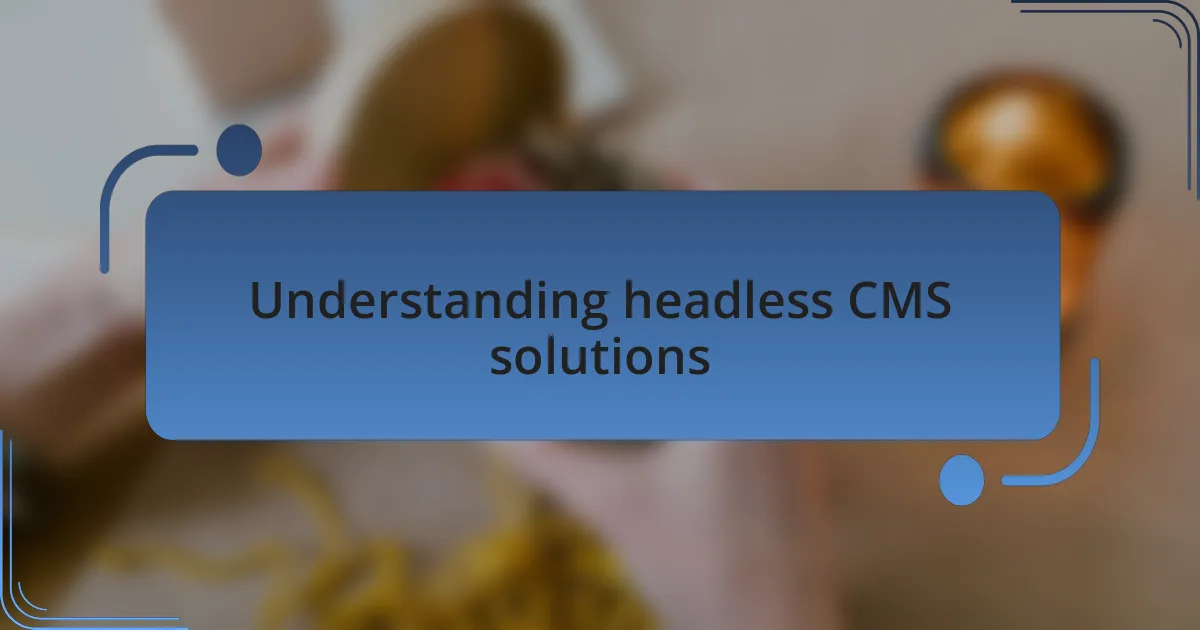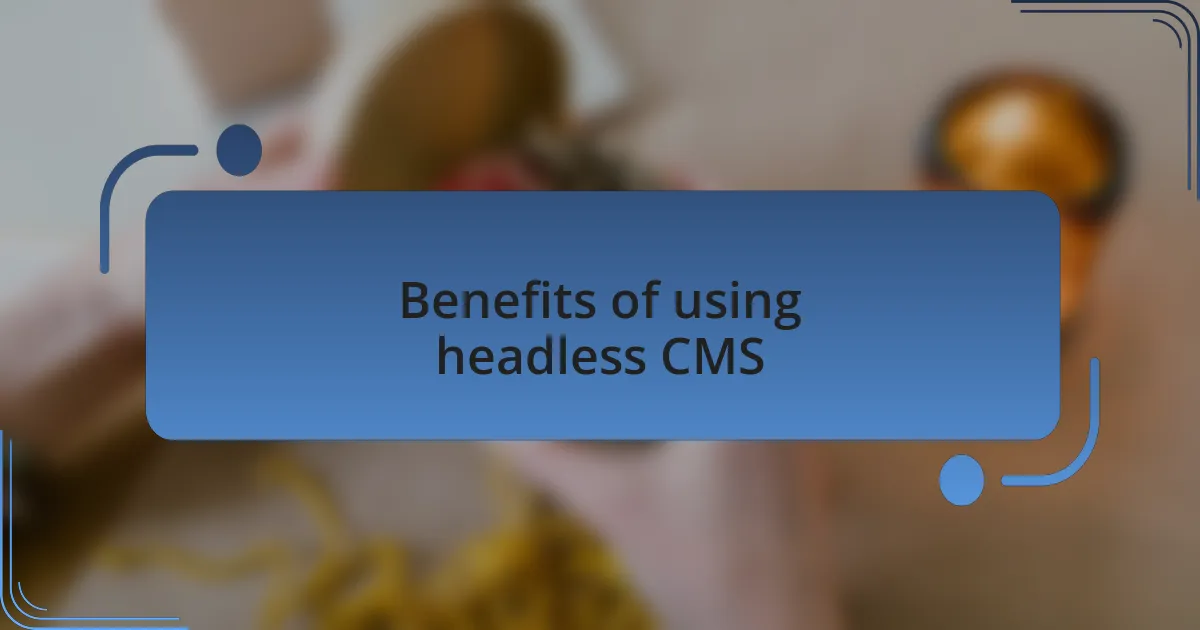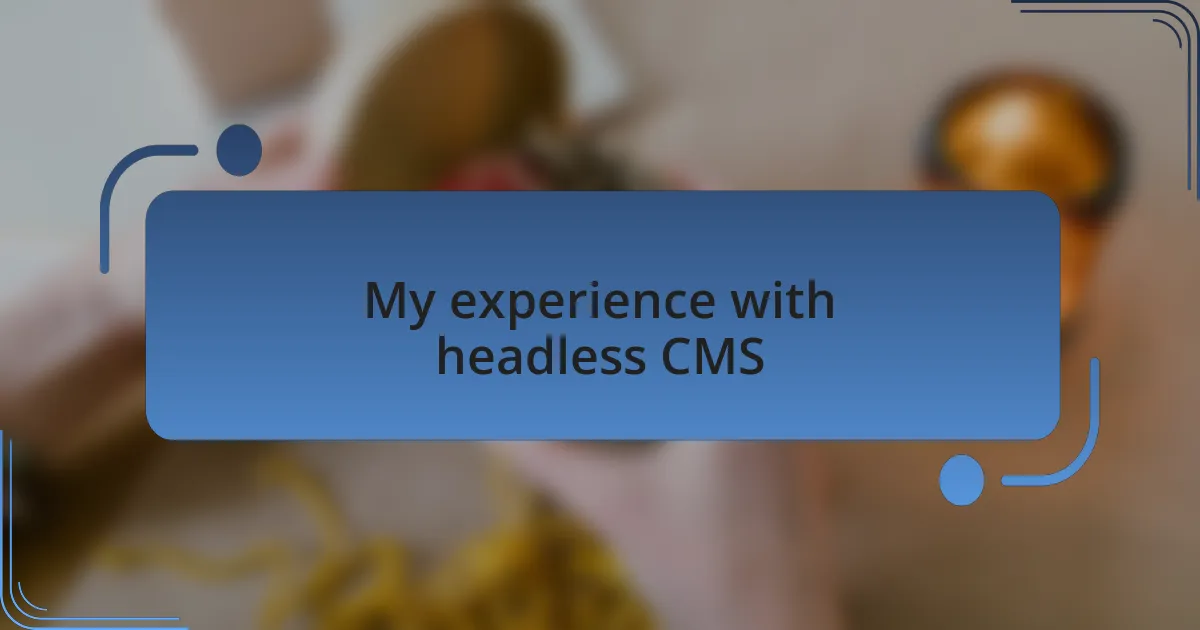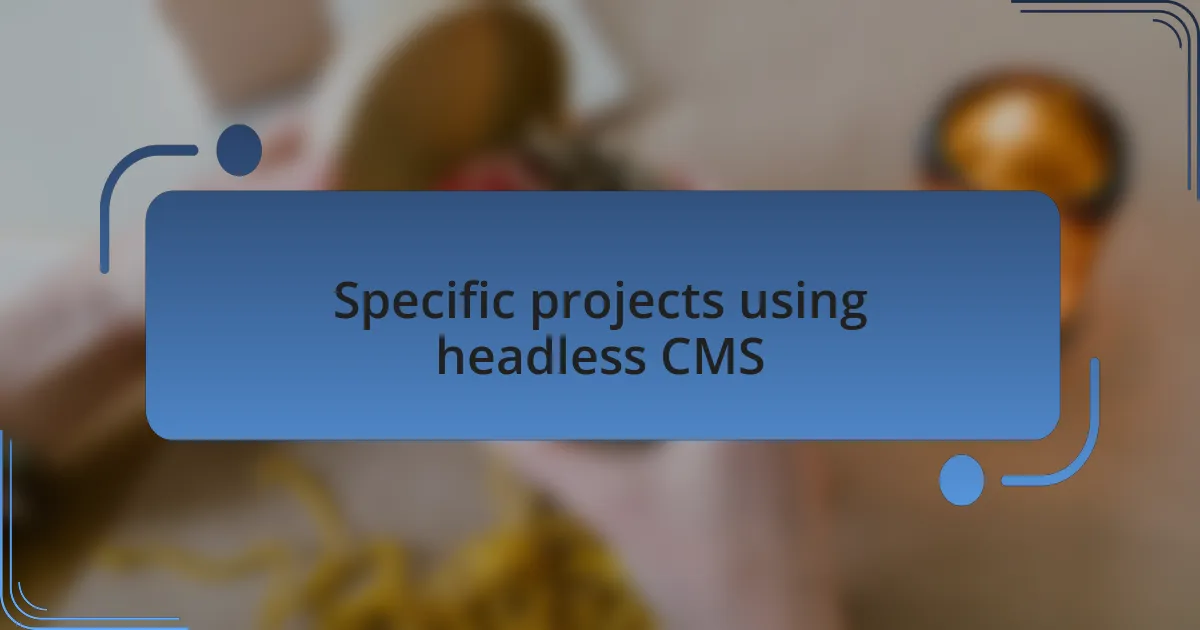Key takeaways:
- Headless CMS decouples content management from front-end presentation, allowing content to be displayed across multiple platforms seamlessly.
- Enhanced flexibility and performance are key benefits, enabling rapid adjustments based on client needs and improving site speed and SEO rankings.
- Scalability is more straightforward with headless CMS, avoiding the cumbersome upgrades often needed with traditional CMS during growth periods.
- Real-world experiences highlight effective use cases in e-commerce, non-profits, and tech startups, showcasing increased creativity and collaboration.

Understanding headless CMS solutions
Headless CMS solutions can seem a bit daunting at first, but once you understand their core concept, they become quite fascinating. Essentially, a headless CMS decouples the content management backend from the front-end presentation layer. This means you can manage your content separately from how it’s displayed, allowing for greater flexibility in terms of design and functionality.
Think about it: when I first encountered a headless CMS, I was intrigued by the idea of being able to deliver the same content across multiple platforms, like websites, apps, and even IoT devices. Does the idea of having unified content management while catering to diverse user experiences resonate with you? For me, it opened up a realm of possibilities that traditional CMS solutions simply couldn’t match.
One significant advantage I’ve experienced with headless CMS solutions is the ability to streamline the development process. Developers can focus on the front end using the tools and frameworks they prefer, without being constrained by the content management system’s limitations. This flexibility not only enhances creativity but also accelerates project timelines, which is often a game changer in web design.

Benefits of using headless CMS
When I think about the benefits of using a headless CMS, the first thing that comes to mind is the instant adaptability it offers. I remember a project where client needs changed midway through the development. Rather than pulling apart the entire system, we simply adjusted the front end while keeping the backend intact. This level of agility can be a lifesaver for teams that need to pivot quickly.
Another key advantage is the enhancement of performance. With a traditional CMS, I often faced slow load times due to the way assets were fetched and displayed. However, using a headless CMS drastically improved site speed. I’ve noticed how much this not only enhances user experience but directly impacts SEO rankings, a critical aspect of any web design strategy.
Finally, the omnichannel capabilities of a headless CMS are truly impressive. Imagine being able to repurpose content effortlessly for a mobile app, a website, or even a digital kiosk without making multiple adjustments. For me, this capability has transformed how I approach content strategy, making it easier to reach audiences across various touchpoints without the redundancies that often bog down projects. Isn’t it liberating to think that our content can have a life beyond a single web page?

Key features of headless CMS
When considering the key features of a headless CMS, one aspect that stands out for me is its flexible API-driven architecture. This design allows developers to connect with different frontends effortlessly. I remember a time when a client approached me with an idea for an app that needed content deliverables. Adapting to that request was seamless because I could leverage the same backend for various platforms without any hiccups.
Another highlight is the content modeling capabilities that headless CMSs offer. I’ve often struggled with rigid content structures in traditional systems, which can limit creativity. With headless CMSs, I can create tailored content types that suit specific needs. It’s like having the freedom to construct your own Lego set rather than being confined to a predefined kit. Isn’t it more exciting to build something unique?
Finally, let’s not overlook the enhanced security features that come with headless systems. In my experience, keeping the frontend separate from the backend significantly reduces the risk of vulnerabilities. It’s like having a well-guarded castle where the gates to the outside world can be controlled effectively. Knowing that my projects have this layer of protection gives me peace of mind, allowing me to focus on delivering quality designs without constantly worrying about potential threats.

Comparing headless and traditional CMS
When I compare headless and traditional CMS, one thing that often strikes me is the difference in flexibility. Traditional CMS platforms tend to lock you into a specific way of doing things, which can be frustrating, especially if you want to pivot quickly based on user feedback or market demands. I recall a project where the limitations of a traditional CMS forced us to abandon a feature that could have enhanced user engagement. Wouldn’t it have been beneficial to have options that allowed us to adapt our strategy on the fly?
Another consideration I frequently think about is scalability. With traditional CMS, scaling can feel like an uphill battle, often requiring significant upgrades or migrations. In a past situation, I was collaborating on a large e-commerce site that struggled during peak sales periods, primarily due to overburdened infrastructure. This led to downtime that directly impacted sales. With a headless setup, scaling can be more straightforward, allowing businesses to grow without those frustrating roadblocks.
Lastly, I’ve noticed that the user experience often differs vastly between the two types. Traditional CMS interfaces can sometimes feel clunky and outdated, which can dampen creativity and hinder productivity. I remember working with a newer client who was transitioning to a headless CMS, and the initial delight in their team’s eyes when they discovered how intuitive and streamlined the process was was palpable. Isn’t it inspiring when technology empowers creativity instead of stifling it?

My experience with headless CMS
When I first explored headless CMS solutions, I was struck by how liberating the experience felt. I worked on a project where we needed to integrate multiple content types across various platforms. With a traditional CMS, managing that would have been cumbersome, but headless allowed us to distribute content seamlessly, making the user experience much more cohesive. Can you imagine the satisfaction of launching a feature without the tech constraints I used to face?
I vividly recall an instance where I had a vision for a dynamic content experience but felt constrained by traditional systems. Shifting to a headless CMS not only made implementing that vision easier but also boosted team morale. The relief on my colleagues’ faces during brainstorming sessions, now equipped with tools that encouraged creativity, was incredible. Isn’t it amazing how the right tools can turn an overwhelming task into an exciting opportunity?
Another key takeaway from my journey with headless CMS is the power of personalization. In one project, we leveraged data to tailor content to individual users, something I found challenging in traditional setups. The thrill of seeing user engagement metrics soar was exhilarating. It opened my eyes to the future of content management and how it can profoundly impact user relationships, don’t you think?

Specific projects using headless CMS
One project that stands out is when I collaborated with an e-commerce client looking to revamp their online store. By using a headless CMS, we were able to seamlessly integrate their inventory management system with a beautifully designed front end. The ability to update product content instantly, without disrupting the customer experience, felt like unlocking a new level in our workflow. Isn’t it thrilling to watch a project come together so fluidly?
Another example comes from a non-profit organization that aimed to enhance its digital storytelling. We needed to showcase various multimedia elements to engage potential donors. Utilizing a headless CMS, we crafted a dynamic site where videos, infographics, and articles could coexist effortlessly. The excitement was palpable as we gathered feedback; users appreciated how easy it was to navigate diverse content types. Can’t you just picture the impact that such a well-organized platform can have on a cause?
Lastly, I participated in a project for a tech startup that required rapid content iterations. With a headless CMS, we could quickly launch, test, and revise landing pages based on user feedback. This agile approach not only accelerated our launch timeline but fostered a collaborative environment among the teams. It was a revelation to see how empowering developers and marketers to work side by side, with minimal roadblocks, could lead to innovative solutions. Have you ever experienced that feeling of being part of a truly collaborative project? It’s incredibly rewarding.